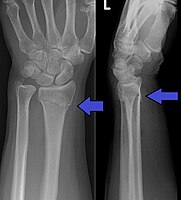
Photo from wikipedia
Purpose The aim of surgical treatment for lateral compression type 2 (LC-2) pelvic fractures is to enable early mobilization and provide pain relief. Anterior and posterior ring fixation is usually… Click to show full abstract
Purpose The aim of surgical treatment for lateral compression type 2 (LC-2) pelvic fractures is to enable early mobilization and provide pain relief. Anterior and posterior ring fixation is usually performed simultaneously, with the goal of providing good biomechanical stability. However, it is unclear whether anterior ring fixation is necessary. This study therefore aimed to determine the feasibility of isolated posterior ring fixation for LC-2 pelvic fractures. Methods Records of patients with LC-2 pelvic fractures were extracted from a medical database. Patients who underwent posterior pelvic ring fixation alone (PR fixation group) or anterior and posterior ring fixation (APR fixation group) were included. Patients’ operative characteristics, time to clinical healing, length of hospital stay, time to weight bearing, and complications were recorded at follow-up. Radiography was used to assess healing and fracture displacement. Functional outcomes were evaluated using the Majeed grading system. Results The PR fixation group included 44 patients, and the APR fixation group included 49 patients. Operative time, intra-operative blood loss, units of blood transfused, intra-operative fluid administered, and post-operative drainage were lower in the PR fixation group than in the APR fixation group. Length of hospital stay was also shorter in the PR fixation group than in the APR fixation group. Although the frequency (8/44) of fracture displacement in the superior ramus prior to union was high in the PR fixation group, no significant differences in time to weight bearing, time to clinical healing, or Majeed scores were found between the groups at follow-up. Conclusions Isolated posterior ring fixation for LC-2 pelvic fractures is feasible; patients who underwent treatment with this technique had functional outcomes similar to that of those who underwent anterior and posterior ring fixation.
Journal Title: International Orthopaedics
Year Published: 2020
Link to full text (if available)
Share on Social Media: Sign Up to like & get
recommendations!